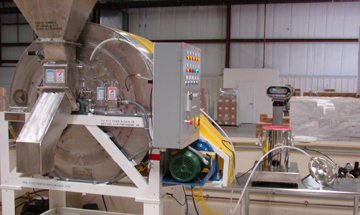Creating distinctive teas is challenging, yet essential to private label success.
Hand blending tea with dried fruit, flowers and flavors is a long-practiced art undertaken by master blenders who each leave an indelible idiosyncratic mark. It can take years of experiments to achieve the perfect blend of tea, flavor enhancements and embellishments.
And that’s the easy part. It is only then you discover the challenges of scaling these qualities with the consistency customer’s demand.
Customers respond to variety; retail economics favor quantity. Years of retail experience led to consumer favorites from Earl Grey to Jasmine Pearl but these are now available anywhere. What sets your retail shop apart is experimenting with variations inspired by trends and seasons. Once you achieve success, you must have the production capacity and flexibility to balance supply and demand.
These conflicting requirements led the gourmet tea industry to discover the Rollo-Mixer, a slow RPM rotary drum batch mixer from Milwaukee, Wis.-based Continental Products Corp. It is a versatile mixer capable of blending and flavoring batches of tea from 25 lbs. to 25,000 lbs. at a time.
Let’s say the Greenbrier in West Virginia favors a tea blended with eight scoops of peach shavings while a tea house in Palm Beach, Florida prefers six, says CPC’s President John Callaghan. “The Rollo-Mixer allows blenders to tweak the outcome of the finished tea and replicate it regardless of quantity,” says Callaghan. Scaling is precise. “We can put 25 pounds in a 10 cubic foot mixer, perfect the sample and immediately scale up to run as many 250-pound batches as you like in the same machine,” he explains. This avoids wasting raw product during testing and insures consistency in the finished blend, he says.
The device, which was invented in 1960, serves many industries, from dietary powders and vitamin supplements to blending finely ground aluminum. It is also used to make kitty litter and coat potassium powder carbonate with hot wax. “What sets our mixing and coating technology apart is the ability to uniformly blend particles of dissimilar size and density, while coating them evenly with liquid additives,” says Callaghan. “That makes it perfect for tea,” he says. Free-Fall processing, exclusive to the Rollo-Mixer, exposes the entire surface area of the batch.
Michael Cramer, President of Adagio Teas, has high praise for the Rollo-Mixer which is used to blend his own line of premium teas. The equipment’s flexibility allowed us to fine tune the taste. We actually added a line of business,” he tells the video audience. Adagio now offers custom blends for our customers. “They can ask for a particular blend unlike our own, with perhaps nine or 12 scoops of enhancements, and we can do that,” says Cramer.
“It’s really a simple mixing device that folds and divides each batch,” says Callaghan. Most operations take one person to operate and unlike ribbon blenders, the Rollo-Mixer does not damage tea leaves or ingredients, as it turns at a gentle 3 RPM. In nine revolutions the batch is uniformly exposed allowing for precise “private label” amounts of exclusive liquid flavor to be added. Dry enhancements are distributed evenly. Click here to see how it works.
“It’s like there are a bunch of guys with shovels in there, gently turning the batch. There is no fractured product resulting in “mechanically hand blended teas” and the entire process can take as little as three to five minutes,” says Callaghan.
